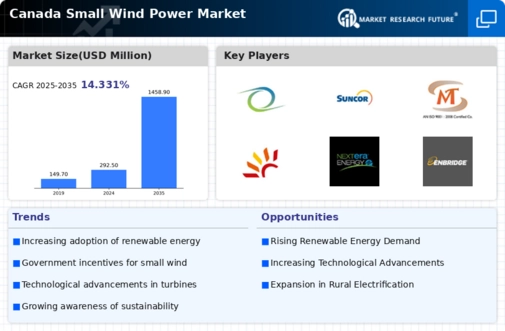Rising Energy Costs
The small wind-power market in Canada is experiencing a notable increase in demand due to rising energy costs. As traditional energy prices fluctuate, consumers and businesses are seeking alternative energy sources to mitigate expenses. The average cost of electricity in Canada has risen by approximately 3.5% annually over the past few years, prompting a shift towards renewable energy solutions. This trend is particularly evident in rural areas where grid access is limited, making small wind systems an attractive option. The small wind-power market is thus positioned to benefit from this economic pressure, as more individuals and organizations consider investing in small wind turbines to achieve energy independence and cost savings.
Technological Innovations
Technological innovations play a pivotal role in shaping the small wind-power market in Canada. Advances in turbine design, materials, and energy storage solutions have significantly improved the efficiency and reliability of small wind systems. For example, the introduction of vertical-axis wind turbines has expanded the potential for urban installations, where space is limited. Furthermore, the integration of smart grid technologies allows for better energy management and optimization of wind energy usage. These innovations not only enhance the performance of small wind systems but also contribute to the overall growth of the small wind-power market, making it a more viable option for diverse applications.
Increased Public Awareness
Increased public awareness regarding climate change and sustainability is driving interest in the small wind-power market in Canada. As citizens become more informed about the environmental impacts of fossil fuels, there is a growing demand for clean energy solutions. Surveys indicate that approximately 70% of Canadians support the transition to renewable energy sources, which includes wind power. This heightened awareness is influencing consumer behavior, leading to a rise in inquiries and installations of small wind systems. The small wind-power market is thus likely to see continued growth as public sentiment increasingly favors sustainable energy practices.
Supportive Regulatory Framework
The small wind-power market in Canada is bolstered by a supportive regulatory framework that encourages the adoption of renewable energy technologies. Various provinces have implemented policies that facilitate the installation of small wind systems, including streamlined permitting processes and interconnection standards. For instance, Ontario's Feed-in Tariff program has provided fixed payments for energy produced from small wind installations, enhancing the financial viability of such projects. This regulatory support is crucial for the small wind-power market, as it reduces barriers to entry and fosters a favorable environment for investment and innovation in wind energy technologies.
Rural Electrification Initiatives
Rural electrification initiatives are significantly impacting the small wind-power market in Canada. Many remote communities lack access to reliable electricity, making small wind systems an attractive solution for energy generation. Government programs aimed at improving energy access in rural areas often include funding and support for renewable energy projects, including small wind installations. For instance, initiatives in provinces like British Columbia and Manitoba have successfully deployed small wind systems to enhance energy security in off-grid locations. This focus on rural electrification not only addresses energy poverty but also promotes the small wind-power market as a viable alternative for sustainable energy solutions.



















Leave a Comment